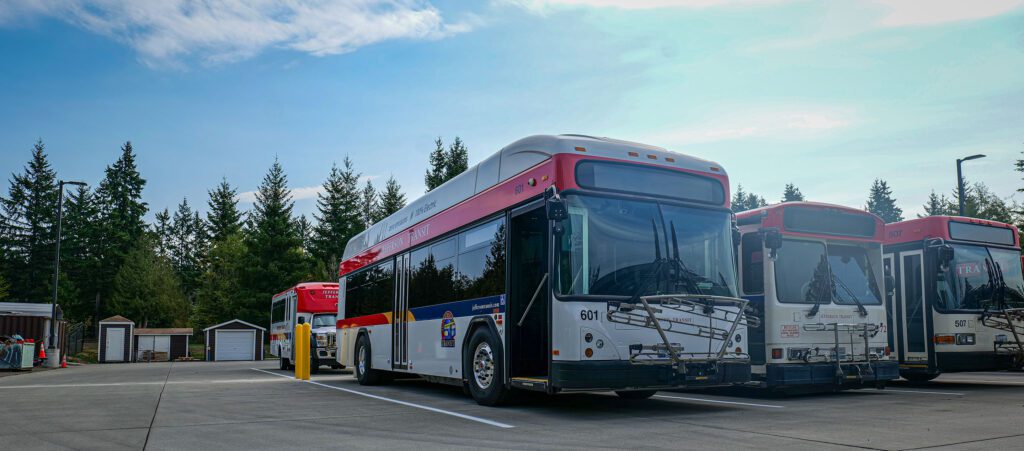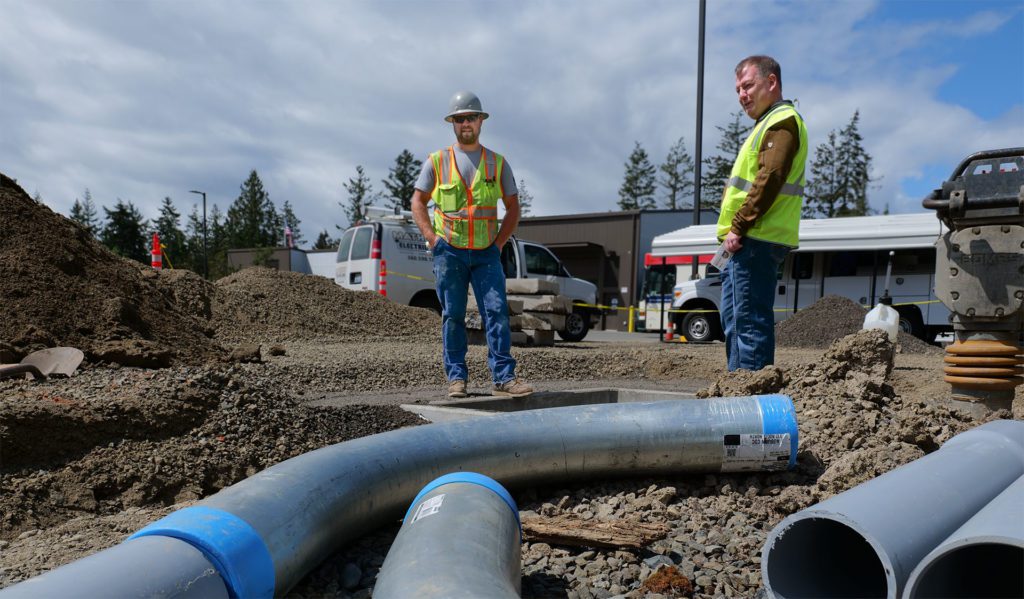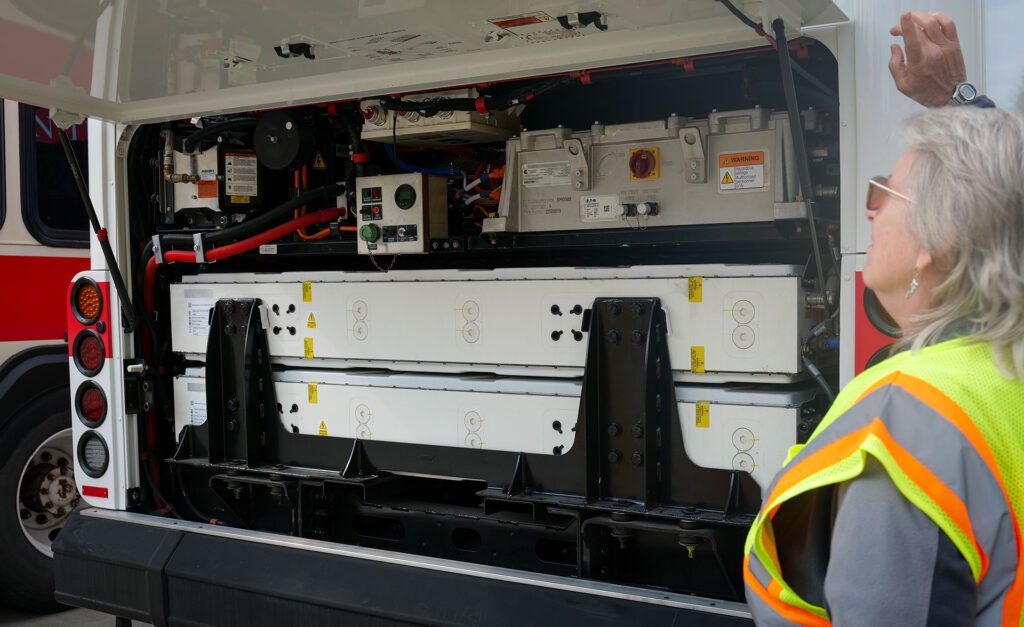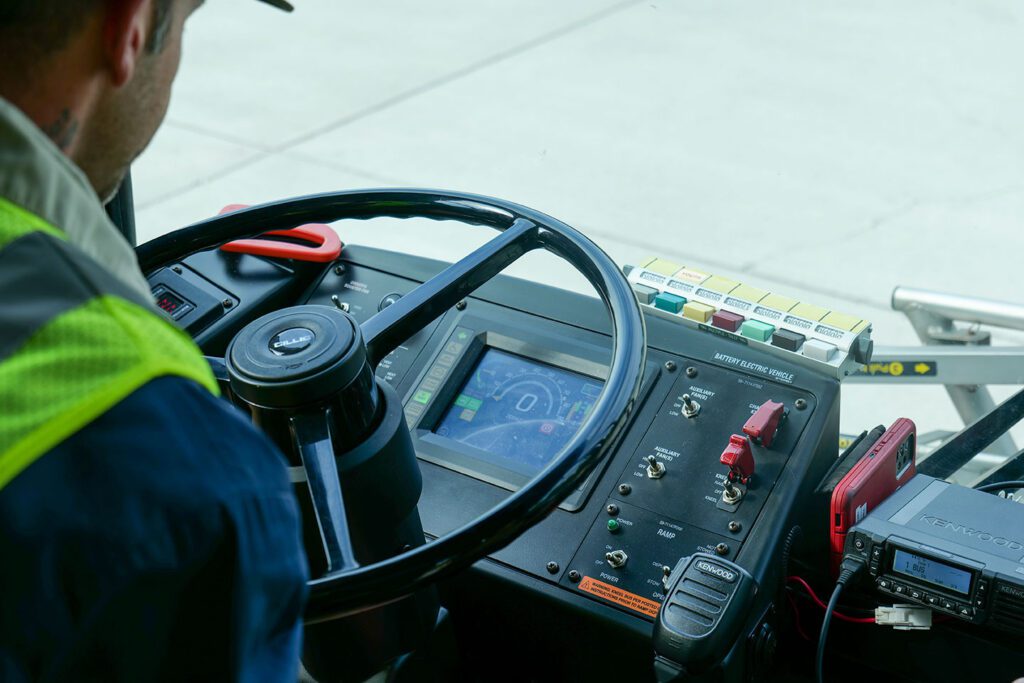Helping Charge the Future of Transit
Jefferson Transit is taking strides toward a zero-emission fleet with its first all-electric bus powered by 96% carbon-free energy from the PUD.

Riding Jefferson Transits new electric bus is an entirely different experience. Yes, it features many of the same traditional bus components–elevated rear area, space for 31 passengers, the essential springy padded seats, and metal handholds throughout, but that’s where the likeness ends.
The first thing I noticed as we exited Jefferson Transits Four Corners Road depot was how quiet the 35-foot bus is. Very, very quiet, in fact. Gone is the traditional hum and thrum of a diesel-powered (or in the case of the Jefferson fleet, biodiesel powered) bus, replaced by quiet battery operation using nearly carbon-free energy from the PUD.
Getting Wheels Rolling
The new bus, which arrived in mid-2023, was made by Gillig in Southern California and has a range of approximately 160 miles per charge. Charging infrastructure for such a large vehicle–and a future fleet of E-buses–required coordination between Transit, PUD, and contract electrical engineers.
Jefferson Transit secured $567K in grant funding for E-fleet infrastructure upgrades to their transit depo. The transit E-fleet wishlist included 8 in-ground induction charging stations and an additional Level 2 charger. Transit currently has two Ford Mach-E vehicles for administrative vehicles.
Power needs on this scale required close coordination between PUD electrical engineering staff and transit contractors, and prompted the installation of a 480-volt, 3-phase transformer by PUD line crews.
“The PUD was instrumental in the design and implementation of this project,” said Nicole Gauthier, Jefferson Transit General Manager. “The PUD took the time to meet with Jefferson Transit staff every step of the way to ensure that our questions were being answered and to help educate us on design options.”
Power Needs at Ground Level

An initial walk-around of the new bus felt much like attending a fancy car show–I mean, this is perhaps the most expensive vehicle I’ll ever ride on with a price tag of more than $900K. Naturally, I had to ask to see what was under the hood. When I asked Desiree Williams, Fleet & Facilities Manager for Transit about the system powering the vehicle, she smiled and pointed at the (now-common) electric port on the side.
“Right now we have a single Level 3 charger in place, and each bus will have the ability to induction charge,” Williams said, gesturing to the underside of the bus.
Of course, I had to scurry on my belly for a closer look. The underside of the bus features an array of large blue pads complete with cameras to assist the driver with positioning the bus over top a charging station. Just over top? Correct. Induction charging does not require physically connecting the bus to power. Instead, the pads on the belly of the bus align with a similar array of in-ground chargers. Simply position the bus over top the pads, use the bus hydraulics to lower it close to the ground, and the fast charging begins.
Unfortunately, supply chain delays have pushed the finalizing of the induction charging project into 2024, so for now the bus is powered using the standard Level 3 charger.

Williams lifts the ‘hood’ on the rear of the bus where (traditionally) a large thrumming diesel engine would reside. Inside, a network of high-voltage cables and equipment surround two large battery packs.
“There are 6 battery packs total,” Williams said, “4 placed in the roof and 2 in the back.”
Roof-mounted battery packs make for a larger bus profile when compared to a traditional bus. Batteries also add weight, with the E-bus tipping the scales at approximately 33,000-pounds–roughly 10,000lbs more than a diesel bus.
The shift from a traditional fleet to E-buses has meant new training opportunities for transit maintenance staff to troubleshoot and fix wear items.
Getting a Feel for the E-Bus

For passengers, riding on an E-bus will be much the same, but for the driver it is a new experience.
“It’s so responsive compared to the other buses,” said Michael Norman, Transit maintenance team member taking us on test run. “There’s instant power when you hit the accelerator–even on the uphill’s where a diesel bus will noticeably slow, this can pick up speed.”
Slowing the vehicle’s heft is also different. The E-bus features a regenerative braking system that charges the battery as it decelerates. This saves wear on the large disc brakes and can improve battery run time.
Another big difference for drivers is the noise and vibration. Diesel buses have a characteristic rubble as they shift through gears on the road. The only sound present on the E-bus (beside road noise) is the sound of air vents circulating throughout the cabin.
All systems, from battery storage to camera views are available on a main screen positioned in front of the driver.
An all-electric bus has an approximate run time of 4 hours, with run time for any all-electric vehicle being subject to route topography, outside temperature, and how the vehicle is driven. Adding the bus to an existing rotation of biodiesel-powered vehicles presents new challenges for transit maintenance staff and route scheduling. Diesel buses can operate for up to 12 hours straight, with drivers alternating routes throughout the day. Accurate route management and charging timelines will be key for the future fleet, Gauthier noted.
Hitting the Road with Carbon-Free Energy One Route at a Time
Jefferson PUD’s energy mix from Bonneville Power Administration (BPA) is 85% hydropower and 11% nuclear power which means a cleaner mix for powering an electric bus fleet.
Jefferson Transit is committed to converting its current bio-diesel bus and administrative vehicle fleet to a zero-emissions fleet as each vehicle reaches its useful life benchmark, said Gauthier.
Route testing is still underway for the new E-bus, and Transit staff anticipate it will enter circulation in November of 2023.
In 2023, Jefferson Transit was awarded funding from the Green Transportation Grant to purchase a second battery electric Gillig bus. Jefferson Transit anticipates that bus joining the fleet by mid-2025.